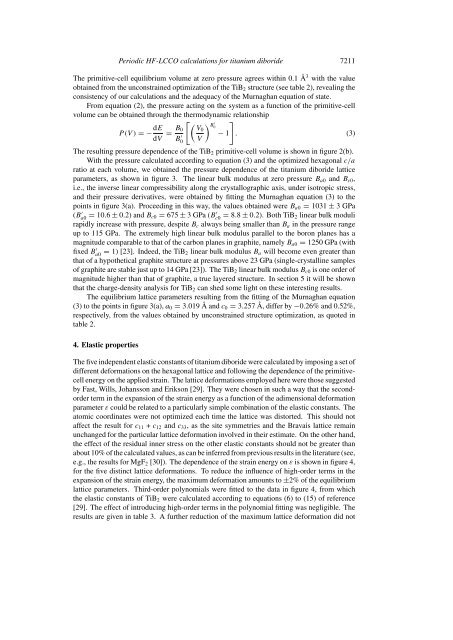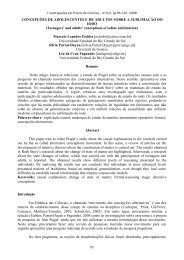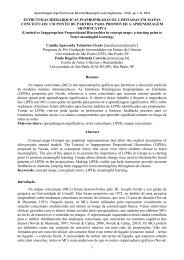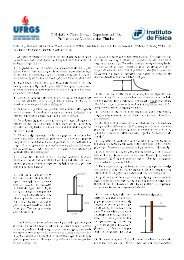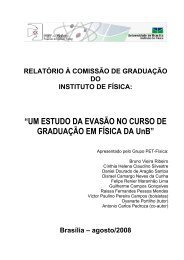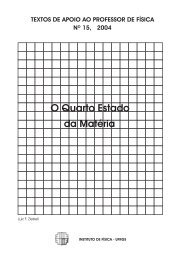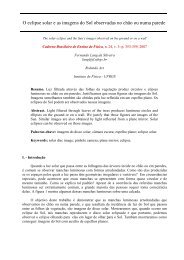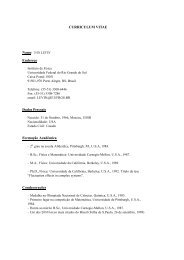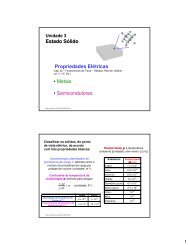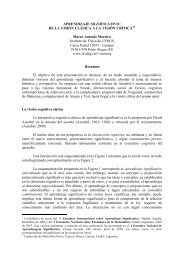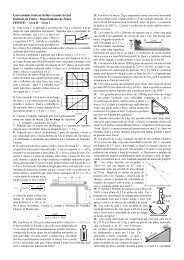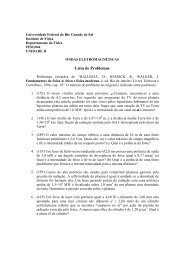Periodic HartreeâFock linear combination of crystalline orbitals ...
Periodic HartreeâFock linear combination of crystalline orbitals ...
Periodic HartreeâFock linear combination of crystalline orbitals ...
You also want an ePaper? Increase the reach of your titles
YUMPU automatically turns print PDFs into web optimized ePapers that Google loves.
<strong>Periodic</strong> HF-LCCO calculations for titanium diboride 7211The primitive-cell equilibrium volume at zero pressure agrees within 0.1 Å 3 with the valueobtained from the unconstrained optimization <strong>of</strong> the TiB 2 structure (see table 2), revealing theconsistency <strong>of</strong> our calculations and the adequacy <strong>of</strong> the Murnaghan equation <strong>of</strong> state.From equation (2), the pressure acting on the system as a function <strong>of</strong> the primitive-cellvolume can be obtained through the thermodynamic relationship[P(V) =− dEdV = B (V0 ) ] B ′00 − 1B0′ . (3)VThe resulting pressure dependence <strong>of</strong> the TiB 2 primitive-cell volume is shown in figure 2(b).With the pressure calculated according to equation (3) and the optimized hexagonal c/aratio at each volume, we obtained the pressure dependence <strong>of</strong> the titanium diboride latticeparameters, as shown in figure 3. The <strong>linear</strong> bulk modulus at zero pressure B a0 and B c0 ,i.e., the inverse <strong>linear</strong> compressibility along the crystallographic axis, under isotropic stress,and their pressure derivatives, were obtained by fitting the Murnaghan equation (3) to thepoints in figure 3(a). Proceeding in this way, the values obtained were B a0 = 1031 ± 3GPa(Ba0 ′ = 10.6 ± 0.2) and B c0 = 675 ± 3GPa(Bc0 ′ = 8.8 ± 0.2). Both TiB 2 <strong>linear</strong> bulk modulirapidly increase with pressure, despite B c always being smaller than B a in the pressure rangeup to 115 GPa. The extremely high <strong>linear</strong> bulk modulus parallel to the boron planes has amagnitude comparable to that <strong>of</strong> the carbon planes in graphite, namely B a0 = 1250 GPa (withfixed Ba0 ′ = 1) [23]. Indeed, the TiB 2 <strong>linear</strong> bulk modulus B a will become even greater thanthat <strong>of</strong> a hypothetical graphite structure at pressures above 23 GPa (single-<strong>crystalline</strong> samples<strong>of</strong> graphite are stable just up to 14 GPa [23]). The TiB 2 <strong>linear</strong> bulk modulus B c0 is one order <strong>of</strong>magnitude higher than that <strong>of</strong> graphite, a true layered structure. In section 5 it will be shownthat the charge-density analysis for TiB 2 can shed some light on these interesting results.The equilibrium lattice parameters resulting from the fitting <strong>of</strong> the Murnaghan equation(3) to the points in figure 3(a), a 0 = 3.019 Å and c 0 = 3.257 Å, differ by −0.26% and 0.52%,respectively, from the values obtained by unconstrained structure optimization, as quoted intable 2.4. Elastic propertiesThe five independent elastic constants <strong>of</strong> titanium diboride were calculated by imposing a set <strong>of</strong>different deformations on the hexagonal lattice and following the dependence <strong>of</strong> the primitivecellenergy on the applied strain. The lattice deformations employed here were those suggestedby Fast, Wills, Johansson and Erikson [29]. They were chosen in such a way that the secondorderterm in the expansion <strong>of</strong> the strain energy as a function <strong>of</strong> the adimensional deformationparameter ε could be related to a particularly simple <strong>combination</strong> <strong>of</strong> the elastic constants. Theatomic coordinates were not optimized each time the lattice was distorted. This should notaffect the result for c 11 + c 12 and c 33 , as the site symmetries and the Bravais lattice remainunchanged for the particular lattice deformation involved in their estimate. On the other hand,the effect <strong>of</strong> the residual inner stress on the other elastic constants should not be greater thanabout 10% <strong>of</strong> the calculated values, as can be inferred from previous results in the literature (see,e.g., the results for MgF 2 [30]). The dependence <strong>of</strong> the strain energy on ε is shown in figure 4,for the five distinct lattice deformations. To reduce the influence <strong>of</strong> high-order terms in theexpansion <strong>of</strong> the strain energy, the maximum deformation amounts to ±2% <strong>of</strong> the equilibriumlattice parameters. Third-order polynomials were fitted to the data in figure 4, from whichthe elastic constants <strong>of</strong> TiB 2 were calculated according to equations (6) to (15) <strong>of</strong> reference[29]. The effect <strong>of</strong> introducing high-order terms in the polynomial fitting was negligible. Theresults are given in table 3. A further reduction <strong>of</strong> the maximum lattice deformation did not


